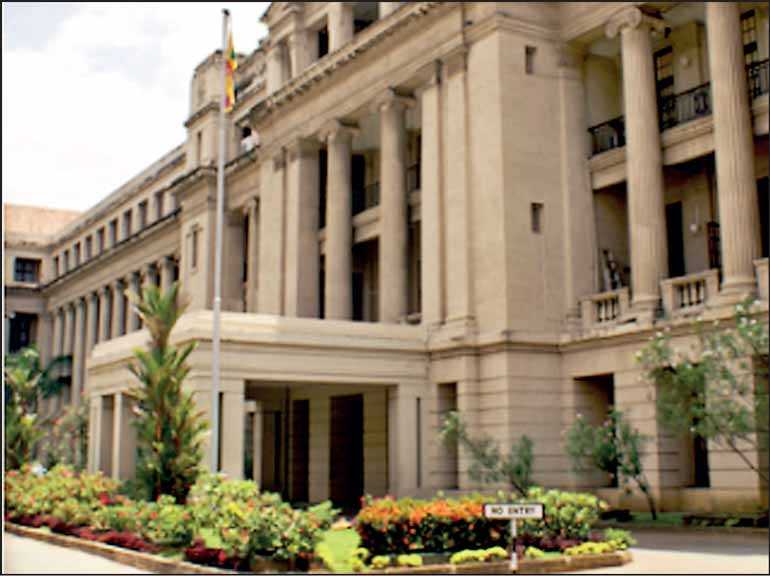Thursday Apr 24, 2025
Thursday Apr 24, 2025
Friday, 13 September 2019 00:00 - - {{hitsCtrl.values.hits}}

Moody’s Investors Service yesterday warned liabilities of State-Owned Enterprises (SOEs) in several countries including Sri Lanka have increased and could pose contingent risk to Government balance sheets.
The new report looked at challenges posed by SOEs in Asian economies and warned that as explicit or direct liabilities are primarily driven by Government guarantees, governments that provide a larger quantity of such support also end up correspondingly more vulnerable. Such guarantees are large and have risen in Malaysia (A3 stable), the Maldives (B2 negative) and Sri Lanka (B2 stable), Moody’s said.
Public private partnership (PPP) liabilities are growing in a number of economies, from a low base, it added.
Government guarantees have increased substantially in some countries. Government guarantees play a crucial role in lowering cost of financing for SOEs, allowing for greater returns on investment. But they are a form of support that gives rise to explicit contingent liabilities.
“In general, Government-guaranteed debt is not large in APAC ex-China, averaging about 4% of GDP in countries across the region. The exceptions are Malaysia, the Maldives, Vietnam, Sri Lanka and Japan (A1 stable), where such debt ranges from 7% to close to 19% of GDP.
In the Maldives, guaranteed debt has risen sharply over recent years, while in Malaysia and Sri Lanka it has also grown significantly,” the report said.
Some sovereigns, including the Philippines (Baa2 stable), Thailand and Vietnam, have conversely recorded declines in Government guarantees. In some cases, greater fiscal space has reduced their need to rely on SOEs to undertake spending or to guarantee their debts, while in others tighter control on the extension of such guarantees has driven the decrease.
Implicit liabilities present greater risks, particularly for a handful of governments, the report goes onto say. These typically arise from quasi-fiscal operations of SOEs. Availability of information on the financial health of SOEs varies, from rated (rich information set), to listed (publicly available financial statements), and unlisted entities (limited information).
“We assess that contingent risks are most significant from unlisted SOEs for frontier markets, including Papua New Guinea (PNG, B2 stable), Bangladesh (Ba3 stable), Sri Lanka and Vietnam (Ba3 stable), where spillovers to the broader sovereign credit profile would be greatest.”
In some advanced economies – Korea (Aa2 stable) and Taiwan (Aa3 stable) – and emerging markets – Indonesia (Baa2 stable), India (Baa2 stable), Malaysia and Thailand (Baa1 positive) – rated as well as some listed, unrated SOEs show weak financials.
“Our findings suggest that liabilities are most likely to materialise from unlisted, unrated SOEs in frontier markets, including PNG, Bangladesh, Sri Lanka and Vietnam. For these relatively lowly rated sovereigns, and in other countries where we assess fiscal strength to be weak, there could be spillovers to the broader sovereign credit profile if these liabilities crystallised.”
Management of liabilities is a key consideration for sovereign implications. Government practices to calculate and quantify risks, and frameworks to control them, are important factors in gauging the probability of contingent liability materialisation. The robustness of these frameworks relates to Moody’s assessment of a sovereign’s institutional strength. In terms of explicit liabilities, with the report finding that management is weakest and potential for crystallisation strongest in the Maldives.
Data indicates that in most countries it is typically public utilities (oil and gas, electricity) or infrastructure (airlines, construction, heavy engineering) SOEs that are most heavily indebted and face financial stress. The IMF’s data on events of crystallisation of contingent liabilities also feature a number of companies in these sectors.
“Such stresses are generally more pronounced for frontier and emerging market sovereigns. Unlisted, unrated entities in PNG, Bangladesh, Sri Lanka and Vietnam, as well as Taiwan, have high debt ratios, but we expect the implications of liabilities materialising will result in more credit constraints in the frontier economies given their slim or no fiscal buffers.”
The common feature this category of sovereigns share is that they already have weak fiscal profiles and a limited capacity to take on more debt. As such, further fiscal costs would act as a drag on their overall credit profiles and constrain upward rating momentum.
Extending beyond the immediate implications, some of these sovereigns – similar to frontier markets more generally – have weak institutional capacities and frameworks to deal with liabilities once they have crystallised, or to prevent their future occurrence. This implies that the crystallisation of liabilities may not be isolated events but could occur relatively regularly, because of these inherent institutional weaknesses, the report warned.
Discover Kapruka, the leading online shopping platform in Sri Lanka, where you can conveniently send Gifts and Flowers to your loved ones for any event including Valentine ’s Day. Explore a wide range of popular Shopping Categories on Kapruka, including Toys, Groceries, Electronics, Birthday Cakes, Fruits, Chocolates, Flower Bouquets, Clothing, Watches, Lingerie, Gift Sets and Jewellery. Also if you’re interested in selling with Kapruka, Partner Central by Kapruka is the best solution to start with. Moreover, through Kapruka Global Shop, you can also enjoy the convenience of purchasing products from renowned platforms like Amazon and eBay and have them delivered to Sri Lanka.
Discover Kapruka, the leading online shopping platform in Sri Lanka, where you can conveniently send Gifts and Flowers to your loved ones for any event including Valentine ’s Day. Explore a wide range of popular Shopping Categories on Kapruka, including Toys, Groceries, Electronics, Birthday Cakes, Fruits, Chocolates, Flower Bouquets, Clothing, Watches, Lingerie, Gift Sets and Jewellery. Also if you’re interested in selling with Kapruka, Partner Central by Kapruka is the best solution to start with. Moreover, through Kapruka Global Shop, you can also enjoy the convenience of purchasing products from renowned platforms like Amazon and eBay and have them delivered to Sri Lanka.